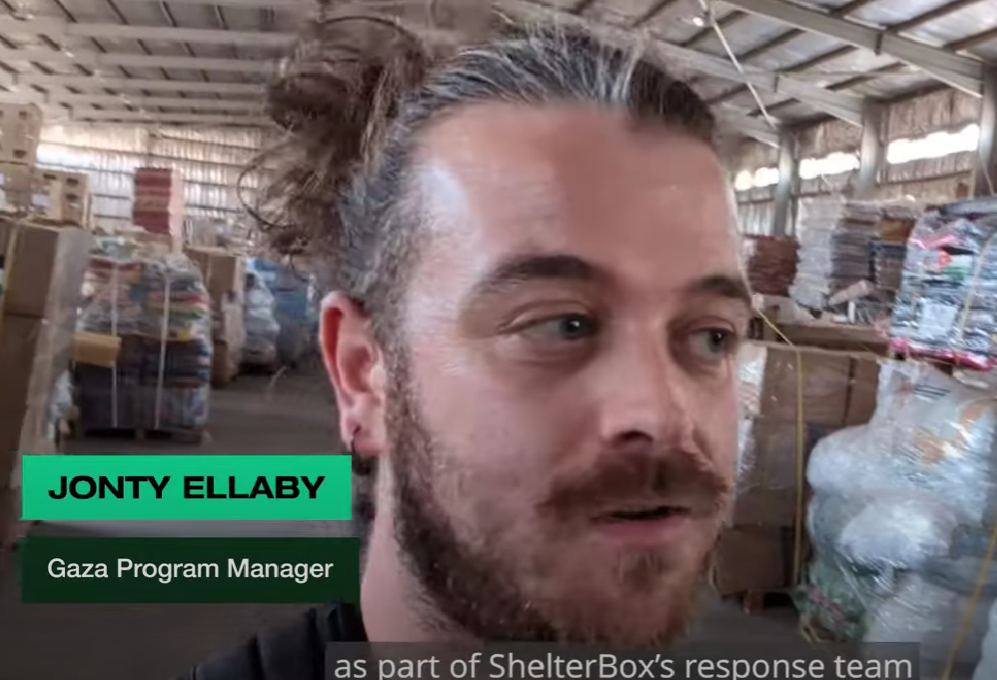June - Preparing for a protracted aid distribution program
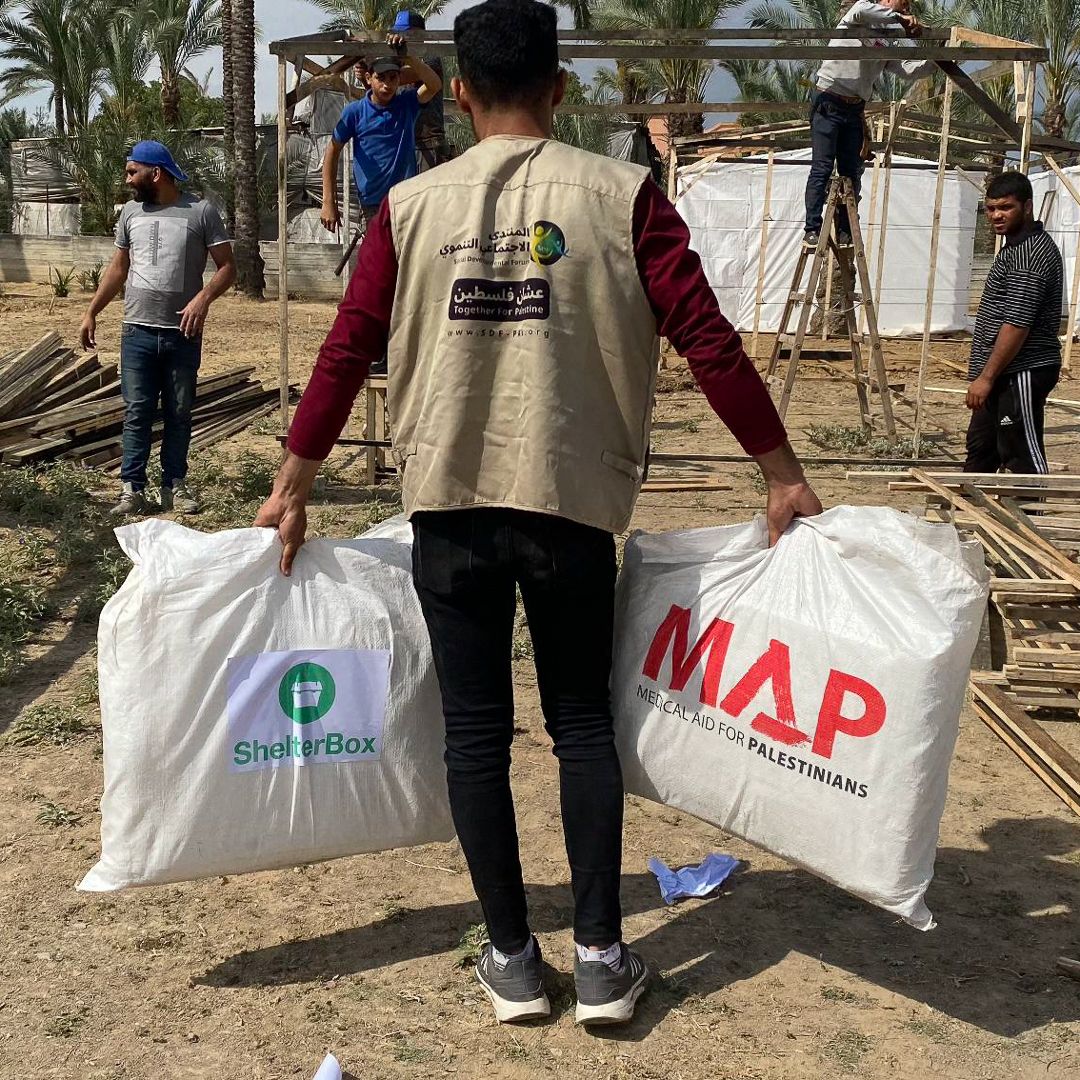
Emergency shelter aid from the first phase of our response has made it into Gaza. In recent days, our trucks have crossed the border at Kerem Shalom in southern Gaza and more shelter supplies are being stored in Jordan ready to make the journey.
Our partners, Medical Aid for Palestinians and Social Development Forum have been distributing our aid and are now be able to reach more people who urgently need support.
In total, 23 trucks have delivered essential items – enough to support thousands of people. Aid items include tarpaulins, rope, mattresses, blankets, floor mats, water carriers and kitchen sets, along with washing sets, nappies, toothbrushes and sanitary items.
It is likely people will need to live in these tents for at least the next year, so we have ensured tents are durable and portable.
Click the image below to hear from Jonty.
24 April - Preparing for aid distribution
Following a series of delays at the Rafah Crossing, ShelterBox is ready to join a convoy of 1,400 trucks to commence delivery of vital supplies
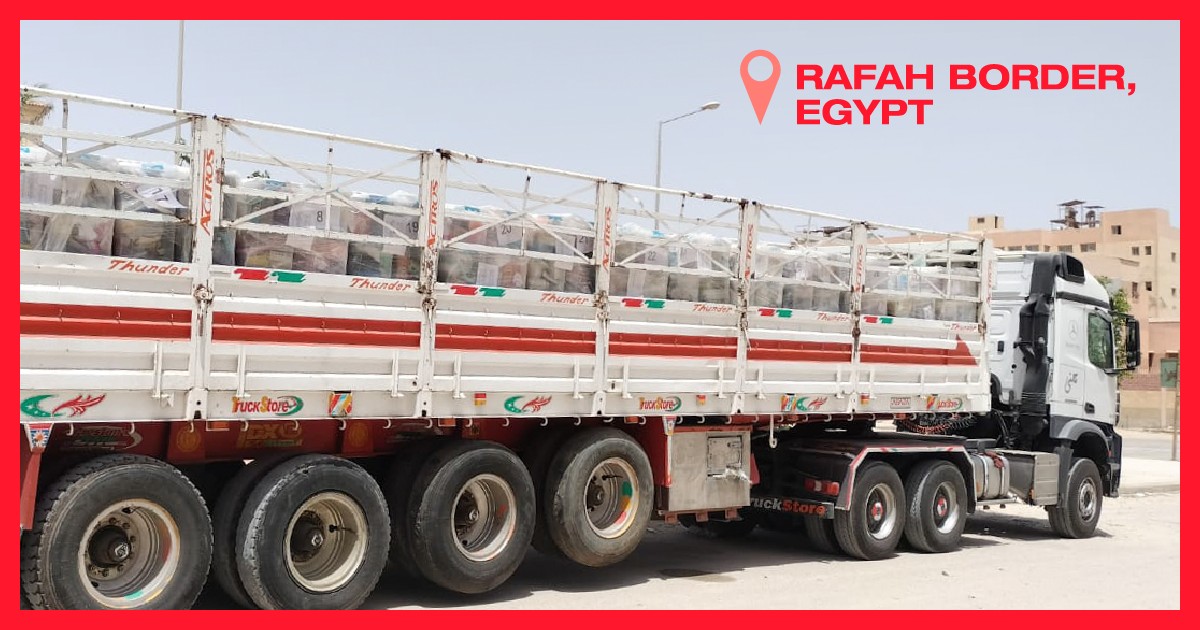
20 March - ShelterBox Response Being Scaled Up
Few buildings are left standing. Millions are entirely homeless. We will begin distributing thousands of tents alongside our other assistance. We continue to call for an immediate humanitarian ceasefire and for the protection of all civilians. Hear from Jonty, ShelterBox Programme Manager.
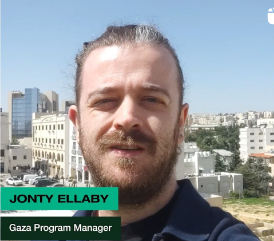
PRESS RELEASE - 8 FEBRUARY
The international disaster relief charity ShelterBox is set to support thousands of people displaced in Gaza with emergency shelter aid and other essential items. In partnership with Medical Aid for Palestinians (MAP), the charity will be providing tarpaulins, rope, and other items so that people can make temporary repairs to damaged buildings that will help keep them watertight and protect them from the weather.
The humanitarian need is growing, with chilling winter temperatures putting the lives of 1.9 million displaced people – more than 85% of the population in Gaza – at risk. People in Gaza were already reliant on humanitarian aid and the current volume of aid crossing into Gaza is fraction of what’s needed.
ShelterBox’s Regional Director for the Middle East and North Africa (MENA), Haroon Altaf says: “Up to 1.9 million people were uprooted from their homes over a two-month period – the scale of the crisis is huge. Let us not forget that behind every number are individuals – children, women, men – who have a name, a family, a story. People are at increasing risk from disease, hunger, and the cold.
“Winter makes things harder in every emergency. It’s cold and wet and people don’t have what they need to protect themselves or their families from the harsh winter weather.”
As well as emergency shelter, ShelterBox and MAP will be providing blankets, mattresses, pillows, and floor mats to help people stay warmer and save lives. The aid package will include washing sets, water carriers, kitchen sets, and items like nappies, toothbrushes, sanitary items, and body/hair wash. Vital items for people with no belongings and unable to return home, or people who have had their homes damaged.
ShelterBox has launched an urgent fundraising appeal to provide emergency shelter and other essential items to people left with nowhere to live in Gaza, and other disasters around the world.
More than 3.1 million people are in need across Gaza and the West Bank. Almost 1.4 million people are sheltering in designated shelters like schools, but many others are living in makeshift collective shelters or out in the open in the street. There is severe overcrowding. Disease is spreading and that’s placing extra strain on the already overwhelmed health system.
Getting aid into countries and on to where it’s needed during times of conflict can be difficult, especially with damage to infrastructure and supply routes. Access to Gaza is limited, so to provide support to people displaced, ShelterBox is partnering with MAP – a medical organisation that was already working in Gaza before the war started. Working together with them, means ShelterBox can get emergency shelter aid and other essential aid items into Gaza, and to the people who need it, more quickly.
ShelterBox’s Programme Manager for Gaza, Jonty Ellaby adds: “Getting aid into Gaza is challenging. It is slow and unpredictable, with border crossings often closed at short notice.
“The situation is complex, but we intend that our aid will reach people in the coming weeks via the Rafah border crossing between Egypt and Gaza.
“Supplies of food, water, and medicine are prioritised for entry, with aid moved into Gaza from Egypt and Jordan via Rafah or the Kerem Shalom border crossing between Israel and Gaza.”
ShelterBox has experience getting aid into Gaza and worked there in 2004, 2008, and 2015. In 2015, ShelterBox distributed emergency shelter aid, thermal blankets, and winter clothing to people in Gaza.
Supporting ShelterBox will help people affected displaced in Gaza and other disasters around the world. The charity believes it can have the most impact for communities by staying flexible. It allows ShelterBox to restock its warehouses ready for the next disaster and provide support to people affected by extreme weather, conflict, and climate crises around the world.
To find out more about the work of ShelterBox across the world, visit shelterbox.org.
ENDS
For more information contact the press office at ShelterBox via [email protected].
Notes to Editors
- Interviews available on request
WHAT IS HAPPENING IN GAZA?

Up to 1.9 million people are displaced across Gaza. That’s 85% of the population with no choice but to shelter in community buildings like schools, makeshift shelters, or out in the open.
There is severe overcrowding and disease is spreading. It’s cold and wet and people don’t have what they need to protect themselves or their families from the harsh winter weather.
Access to water, food and medicine is very difficult. It’s made worse by fuel shortages. Without electricity, people cannot use lights in the dark evenings, keep warm, or cook food. 2.2 million people are at imminent risk of famine.
The number of people who have died since October now exceeds 27,000 people, including more than 10,000 children. This number is rising all the time.
HOW IS SHELTERBOX HELPING?
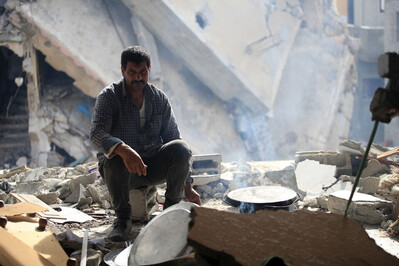
We are providing emergency items like tarpaulins and rope, to help people make damaged buildings and other shelters watertight. Blankets, mattresses, pillows and floormats will help people to stay warm. We’re providing washing sets, water carriers, kitchen sets, and items like nappies, toothbrushes, and sanitary items. All vital items for people with no belongings and unable to return to their homes.
Together with our partner MAP (Medical Aid for Palestinians), we’ll be sourcing items in Egypt and Türkiye. The situation is complex, but we intend that our aid will reach people in the coming weeks via the Rafah border crossing between Egypt and Gaza.
WHERE IS GAZA?
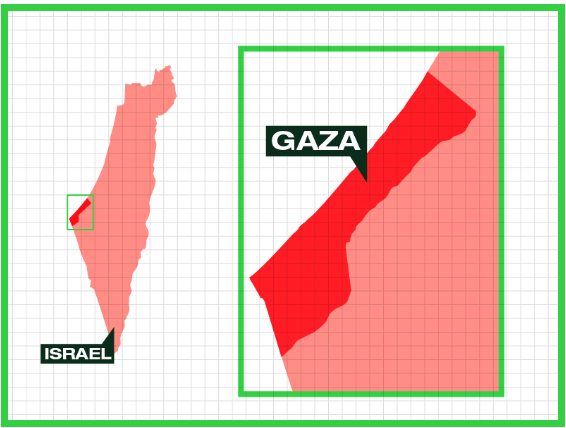
The Gaza Strip is located on the eastern coast of the Mediterranean Sea. It is bordered by Egypt on the southwest and Israel on the east and north.
Gaza is one of the most densely populated pieces of land on Earth. 2.3 million people live on the narrow strip of land, measuring 141sq miles (41km long / 10km wide). Since 7 October 2023, 80% of homes here have been damaged or destroyed.
With civilians unable to leave, nowhere in Gaza is safe. Families are forced to move again and again in search of safety, but land, sea, and air bombardments are making that near impossible. There are large areas cut off and people are continuously on the move.

